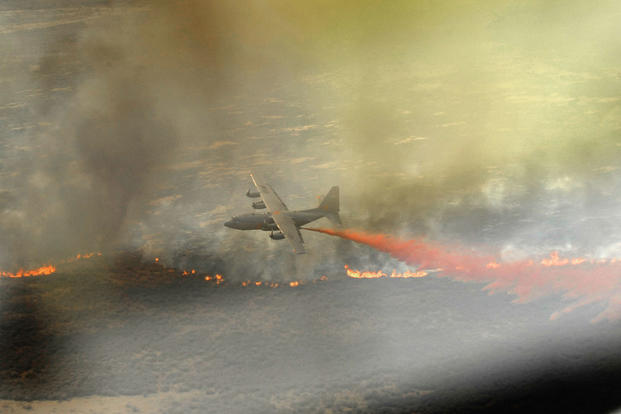Air Force C-130 cargo aircraft designed for firefighting may be used to help battle deadly wildfires scorching thousands of acres in Tennessee, an official said.
Air Force Reserve Command is standing by to deploy C-130s equipped with the Modular Airborne Firefighting System, or MAFFS, which drop hundreds of pounds of fire retardant, according to Ann Skarban, a spokeswoman for the Air Force's 302nd Airlift Wing.
The U.S. Forest Service, the entity responsible for requesting the MAFFS units, hasn't yet determined whether it will require the aircraft but a plan is in place if necessary, Skarban said.
The 302nd Airlift Wing, which houses the aircraft at Peterson Air Force Base in Colorado, has not "received a request through the USFS for MAFFS support for the wildfires in Tennessee" nor have any other airlift wings, she said.
One reason MAFFS have not deployed could be bad weather.
Storms and inclement weather in the Tennessee area have halted any regional aviation assets from taking off, U.S. Forest Service's Southern Region spokesman Adam Rondeau told Military.com on Wednesday.
"Our air operations in Tennessee are currently suspended due to the weather," Rondeau said. "Aviation support will continue once the weather clears."
The Forest Service is on standby to use aircraft over the wildfires, which have spread throughout 15,000 acres from the Great Smoky Mountains into residential areas such as Gatlinburg and Pigeon Forge.
At least four people have died, and 45 others have been injured, according to CNN. More than 250 buildings have been damaged or destroyed.
The Forest Service also prefers to use its own assets before requesting Air Force planes.
The Forest Service has a variety of aircraft at its disposal to battle wildfires, including drones, single engine or large airtankers, Cessnas, or tactical aircraft, according to its website.
In 2014, Congress transferred seven U.S. Coast Guard C-130H cargo planes to the Forest Service for aerial firefighting. The plan, spearheaded by Arizona Republican Sen. John McCain as part of the defense authorization bill, also included 15 C-23B Sherpa cargo planes.
The Pentagon, working with the Forest Service and the National Interagency Fire Center, supplies C-130 H and J model aircraft, flight crews, maintenance and support personnel from Peterson to fly the missions.
"Prior to requesting support from the U.S. Air Force (for which we have a process in place), we would have to fully commit all of our available aviation resources region-wide, which we have yet to do," Rondeau said in an email.
The 302nd has more than 10 qualified crews, according to the service. In 2015, MAFFS-equipped C-130s flew over 15 different fires in California, dropping 842,979 gallons of retardant released in 372 sorties, the Air Force said.
-- Oriana Pawlyk can be reached at oriana.pawlyk@military.com. Follow her on Twitter at @Oriana0214.
Related video:
The Modular Airborne Firefighting System, also known as MAFFS, is self-sufficient technical equipment which can be used on board a cargo aircraft, such as a Lockheed C-130 Hercules, and allows the aircraft to operate in firefighting operations.



























